Redis的两个命令
SETNX key value
setnx 是SET if Not eXists(如果不存在,则 SET)的简写。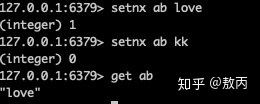
如果不存在set成功返回int的1,这个key存在了返回0。
SETEX key seconds value
将值 value 关联到 key ,并将 key 的生存时间设为 seconds (以秒为单位)。
如果 key 已经存在,setex命令将覆写旧值。
有小伙伴肯定会疑惑万一set value 成功 set time失败,那不就傻了么,这啊Redis官网想到了。
setex是一个原子性(atomic)操作,关联值和设置生存时间两个动作会在同一时间内完成。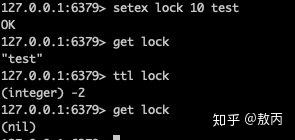
我设置了10秒的失效时间,ttl命令可以查看倒计时,负的说明已经到期了。
跟大家讲这两个命名也是有原因的,因为他们是Redis实现分布式锁的关键。
开始前还是看看场景:
我依然是创建了很多个线程去扣减库存inventory,不出意外的库存扣减顺序变了,最终的结果也是不对的。
单机加synchronized或者Lock这些常规操作我就不说了好吧,结果肯定是对的。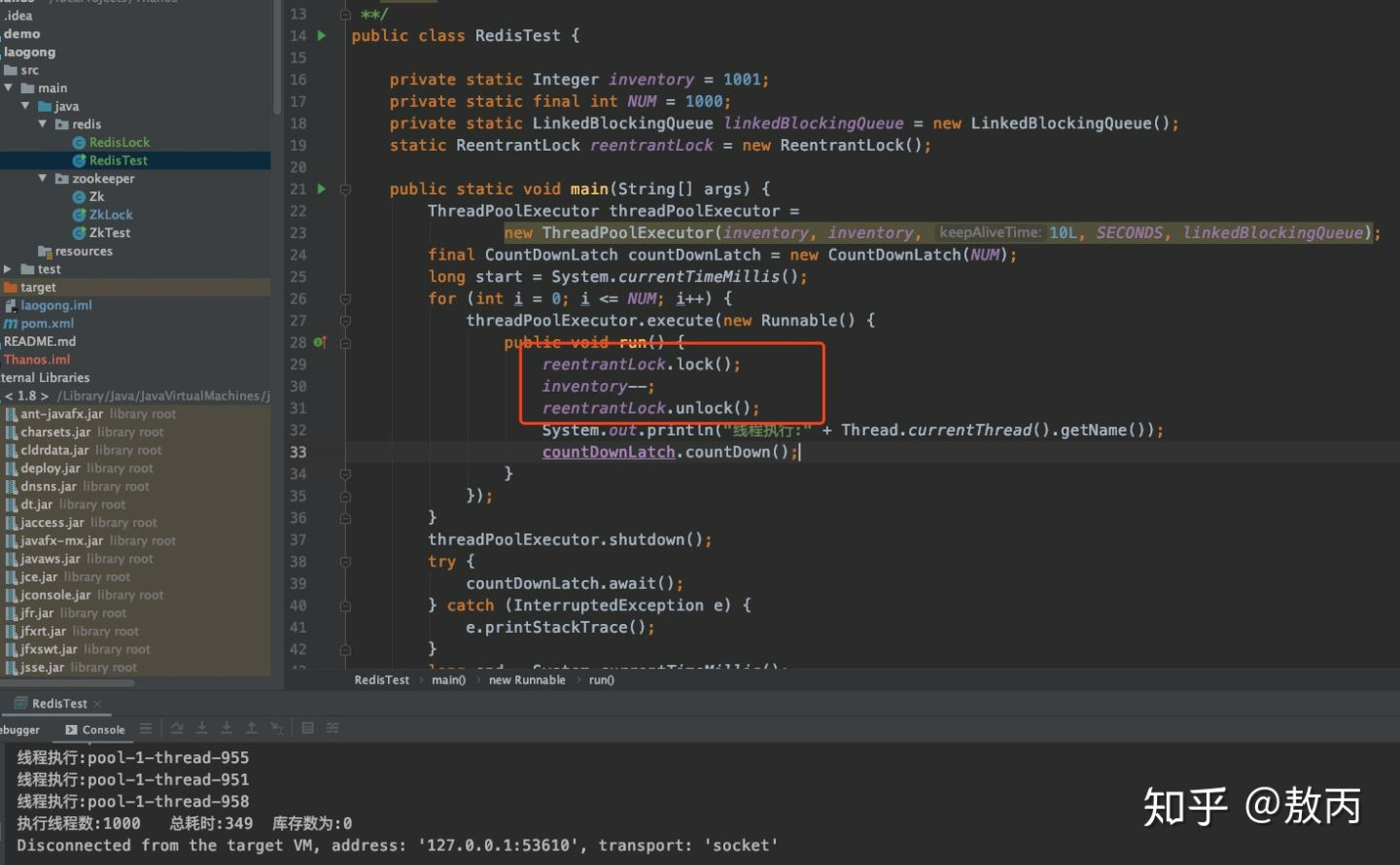
我先实现一个简单的Redis锁,然后我们再实现分布式锁,可能更方便大家的理解。
还记得上面我说过的命令么,实现一个单机的其实比较简单,你们先思考一下,别往下看。
setnx
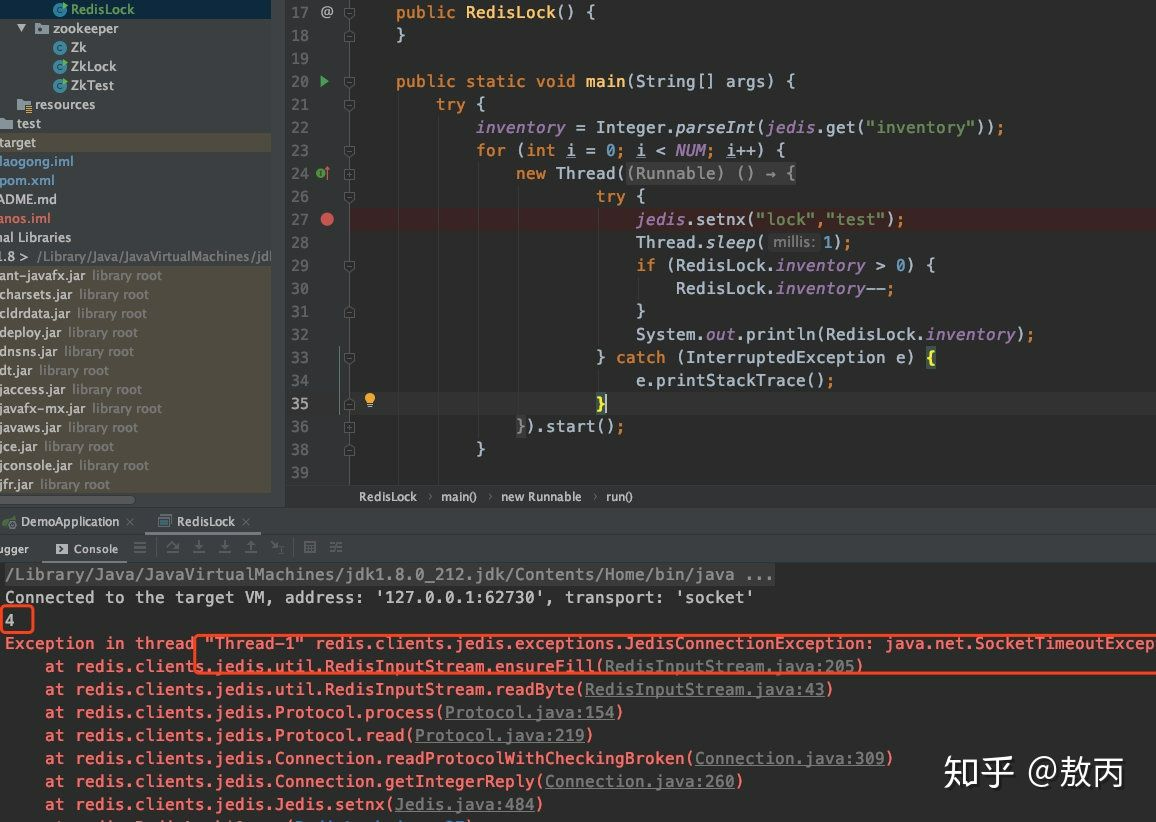
可以看到,第一个成功了,没释放锁,后面的都失败了,至少顺序问题问题是解决了,只要加锁,缩放后面的拿到,释放如此循环,就能保证按照顺序执行。
但是你们也发现问题了,还是一样的,第一个仔set成功了,但是突然挂了,那锁就一直在那无法得到释放,后面的线程也永远得不到锁,又死锁了。
所以….
setex
知道我之前说这个命令的原因了吧,设置一个过期时间,就算线程1挂了,也会在失效时间到了,自动释放。
我这里就用到了nx和px的结合参数,就是set值并且加了过期时间,这里我还设置了一个过期时间,就是这时间内如果第二个没拿到第一个的锁,就退出阻塞了,因为可能是客户端断连了。
加锁
整体加锁的逻辑比较简单,大家基本上都能看懂,不过我拿到当前时间去减开始时间的操作感觉有点笨, System.currentTimeMillis()消耗很大的。
/*** 加锁** @param id* @return*/public boolean lock(String id) {Long start = System.currentTimeMillis();try {for (; ; ) {//SET命令返回OK ,则证明获取锁成功String lock = jedis.set(LOCK_KEY, id, params);if ("OK".equals(lock)) {return true;}//否则循环等待,在timeout时间内仍未获取到锁,则获取失败long l = System.currentTimeMillis() - start;if (l >= timeout) {return false;}try {Thread.sleep(100);} catch (InterruptedException e) {e.printStackTrace();}}} finally {jedis.close();}}
System.currentTimeMillis消耗大,每个线程进来都这样,我之前写代码,就会在服务器启动的时候,开一个线程不断去拿,调用方直接获取值就好了,不过也不是最优解,日期类还是有很多好方法的。
@Service
public class TimeServcie {
private static long time;
static {
new Thread(new Runnable(){
@Override
public void run() {
while (true){
try {
Thread.sleep(5);
} catch (InterruptedException e) {
e.printStackTrace();
}
long cur = System.currentTimeMillis();
setTime(cur);
}
}
}).start();
}
public static long getTime() {
return time;
}
public static void setTime(long time) {
TimeServcie.time = time;
}
}
解锁
解锁的逻辑更加简单,就是一段Lua的拼装,把Key做了删除。
你们发现没,我上面加锁解锁都用了UUID,这就是为了保证,谁加锁了谁解锁,要是你删掉了我的锁,那不乱套了嘛。
LUA是原子性的,也比较简单,就是判断一下Key和我们参数是否相等,是的话就删除,返回成功1,0就是失败。
/**
* 解锁
*
* @param id
* @return
*/
public boolean unlock(String id) {
String script =
"if redis.call('get',KEYS[1]) == ARGV[1] then" +
" return redis.call('del',KEYS[1]) " +
"else" +
" return 0 " +
"end";
try {
String result = jedis.eval(script, Collections.singletonList(LOCK_KEY), Collections.singletonList(id)).toString();
return "1".equals(result) ? true : false;
} finally {
jedis.close();
}
}
验证
我们可以用我们写的Redis锁试试效果,可以看到都按照顺序去执行了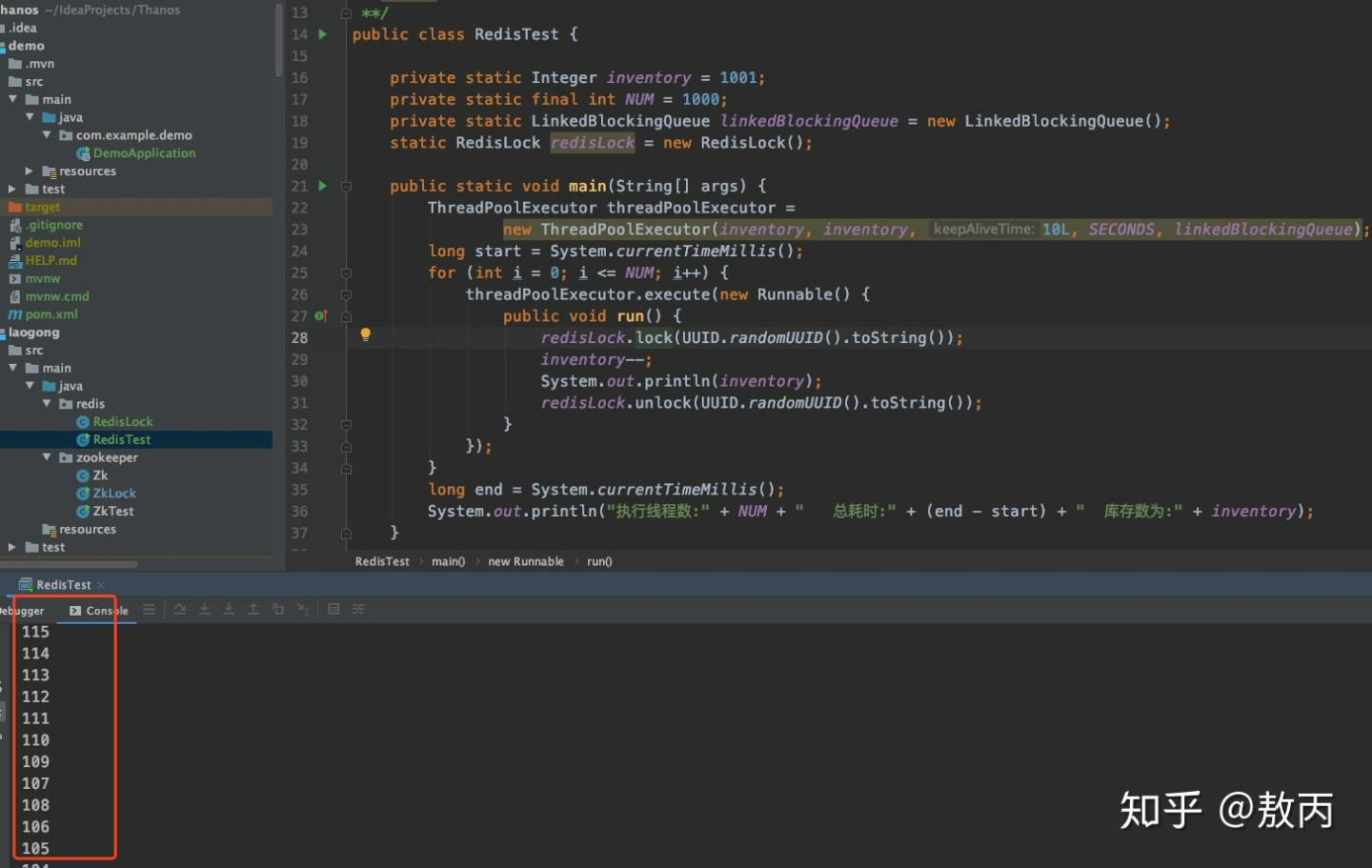
思考
大家是不是觉得完美了,但是上面的锁,有不少瑕疵的,我没思考很多点,你或许可以思考一下,源码我都开源到我的GItHub了。
而且,锁一般都是需要可重入行的,上面的线程都是执行完了就释放了,无法再次进入了,进去也是重新加锁了,对于一个锁的设计来说肯定不是很合理的。
我不打算手写,因为都有现成的,别人帮我们写好了。
redisson
redisson的锁,就实现了可重入了,但是他的源码比较晦涩难懂。
使用起来很简单,因为他们底层都封装好了,你连接上你的Redis客户端,他帮你做了我上面写的一切,然后更完美。
简单看看他的使用吧,跟正常使用Lock没啥区别。
ThreadPoolExecutor threadPoolExecutor =
new ThreadPoolExecutor(inventory, inventory, 10L, SECONDS, linkedBlockingQueue);
long start = System.currentTimeMillis();
Config config = new Config();
config.useSingleServer().setAddress("redis://127.0.0.1:6379");
final RedissonClient client = Redisson.create(config);
final RLock lock = client.getLock("lock1");
for (int i = 0; i <= NUM; i++) {
threadPoolExecutor.execute(new Runnable() {
public void run() {
lock.lock();
inventory--;
System.out.println(inventory);
lock.unlock();
}
});
}
long end = System.currentTimeMillis();
System.out.println("执行线程数:" + NUM + " 总耗时:" + (end - start) + " 库存数为:" + inventory);
上面可以看到我用到了getLock,其实就是获取一个锁的实例。
RedissionLock也没做啥,就是熟悉的初始化。
public RLock getLock(String name) {
return new RedissonLock(connectionManager.getCommandExecutor(), name);
}
public RedissonLock(CommandAsyncExecutor commandExecutor, String name) {
super(commandExecutor, name);
//命令执行器
this.commandExecutor = commandExecutor;
//UUID字符串
this.id = commandExecutor.getConnectionManager().getId();
//内部锁过期时间
this.internalLockLeaseTime = commandExecutor.
getConnectionManager().getCfg().getLockWatchdogTimeout();
this.entryName = id + ":" + name;
}
加锁
有没有发现很多跟Lock很多相似的地方呢?
尝试加锁,拿到当前线程,然后我开头说的ttl也看到了,是不是一切都是那么熟悉?
public void lockInterruptibly(long leaseTime, TimeUnit unit) throws InterruptedException {
//当前线程ID
long threadId = Thread.currentThread().getId();
//尝试获取锁
Long ttl = tryAcquire(leaseTime, unit, threadId);
// 如果ttl为空,则证明获取锁成功
if (ttl == null) {
return;
}
//如果获取锁失败,则订阅到对应这个锁的channel
RFuture<RedissonLockEntry> future = subscribe(threadId);
commandExecutor.syncSubscription(future);
try {
while (true) {
//再次尝试获取锁
ttl = tryAcquire(leaseTime, unit, threadId);
//ttl为空,说明成功获取锁,返回
if (ttl == null) {
break;
}
//ttl大于0 则等待ttl时间后继续尝试获取
if (ttl >= 0) {
getEntry(threadId).getLatch().tryAcquire(ttl, TimeUnit.MILLISECONDS);
} else {
getEntry(threadId).getLatch().acquire();
}
}
} finally {
//取消对channel的订阅
unsubscribe(future, threadId);
}
//get(lockAsync(leaseTime, unit));
}
获取锁
获取锁的时候,也比较简单,你可以看到,他也是不断刷新过期时间,跟我上面不断去拿当前时间,校验过期是一个道理,只是我比较粗糙。
private <T> RFuture<Long> tryAcquireAsync(long leaseTime, TimeUnit unit, final long threadId) {
//如果带有过期时间,则按照普通方式获取锁
if (leaseTime != -1) {
return tryLockInnerAsync(leaseTime, unit, threadId, RedisCommands.EVAL_LONG);
}
//先按照30秒的过期时间来执行获取锁的方法
RFuture<Long> ttlRemainingFuture = tryLockInnerAsync(
commandExecutor.getConnectionManager().getCfg().getLockWatchdogTimeout(),
TimeUnit.MILLISECONDS, threadId, RedisCommands.EVAL_LONG);
//如果还持有这个锁,则开启定时任务不断刷新该锁的过期时间
ttlRemainingFuture.addListener(new FutureListener<Long>() {
@Override
public void operationComplete(Future<Long> future) throws Exception {
if (!future.isSuccess()) {
return;
}
Long ttlRemaining = future.getNow();
// lock acquired
if (ttlRemaining == null) {
scheduleExpirationRenewal(threadId);
}
}
});
return ttlRemainingFuture;
}
底层加锁逻辑
你可能会想这么多操作,在一起不是原子性不还是有问题么?
大佬们肯定想得到呀,所以还是LUA,他使用了Hash的数据结构。
主要是判断锁是否存在,存在就设置过期时间,如果锁已经存在了,那对比一下线程,线程是一个那就证明可以重入,锁在了,但是不是当前线程,证明别人还没释放,那就把剩余时间返回,加锁失败。
是不是有点绕,多理解一遍。
<T> RFuture<T> tryLockInnerAsync(long leaseTime, TimeUnit unit,
long threadId, RedisStrictCommand<T> command) {
//过期时间
internalLockLeaseTime = unit.toMillis(leaseTime);
return commandExecutor.evalWriteAsync(getName(), LongCodec.INSTANCE, command,
//如果锁不存在,则通过hset设置它的值,并设置过期时间
"if (redis.call('exists', KEYS[1]) == 0) then " +
"redis.call('hset', KEYS[1], ARGV[2], 1); " +
"redis.call('pexpire', KEYS[1], ARGV[1]); " +
"return nil; " +
"end; " +
//如果锁已存在,并且锁的是当前线程,则通过hincrby给数值递增1
"if (redis.call('hexists', KEYS[1], ARGV[2]) == 1) then " +
"redis.call('hincrby', KEYS[1], ARGV[2], 1); " +
"redis.call('pexpire', KEYS[1], ARGV[1]); " +
"return nil; " +
"end; " +
//如果锁已存在,但并非本线程,则返回过期时间ttl
"return redis.call('pttl', KEYS[1]);",
Collections.<Object>singletonList(getName()),
internalLockLeaseTime, getLockName(threadId));
}
解锁
锁的释放主要是publish释放锁的信息,然后做校验,一样会判断是否当前线程,成功就释放锁,还有个hincrby递减的操作,锁的值大于0说明是可重入锁,那就刷新过期时间。
如果值小于0了,那删掉Key释放锁。
是不是又和AQS很像了?
AQS就是通过一个volatile修饰status去看锁的状态,也会看数值判断是否是可重入的。
所以我说代码的设计,最后就万剑归一,都是一样的。
public RFuture<Void> unlockAsync(final long threadId) {
final RPromise<Void> result = new RedissonPromise<Void>();
//解锁方法
RFuture<Boolean> future = unlockInnerAsync(threadId);
future.addListener(new FutureListener<Boolean>() {
@Override
public void operationComplete(Future<Boolean> future) throws Exception {
if (!future.isSuccess()) {
cancelExpirationRenewal(threadId);
result.tryFailure(future.cause());
return;
}
//获取返回值
Boolean opStatus = future.getNow();
//如果返回空,则证明解锁的线程和当前锁不是同一个线程,抛出异常
if (opStatus == null) {
IllegalMonitorStateException cause =
new IllegalMonitorStateException("
attempt to unlock lock, not locked by current thread by node id: "
+ id + " thread-id: " + threadId);
result.tryFailure(cause);
return;
}
//解锁成功,取消刷新过期时间的那个定时任务
if (opStatus) {
cancelExpirationRenewal(null);
}
result.trySuccess(null);
}
});
return result;
}
protected RFuture<Boolean> unlockInnerAsync(long threadId) {
return commandExecutor.evalWriteAsync(getName(), LongCodec.INSTANCE, EVAL,
//如果锁已经不存在, 发布锁释放的消息
"if (redis.call('exists', KEYS[1]) == 0) then " +
"redis.call('publish', KEYS[2], ARGV[1]); " +
"return 1; " +
"end;" +
//如果释放锁的线程和已存在锁的线程不是同一个线程,返回null
"if (redis.call('hexists', KEYS[1], ARGV[3]) == 0) then " +
"return nil;" +
"end; " +
//通过hincrby递减1的方式,释放一次锁
//若剩余次数大于0 ,则刷新过期时间
"local counter = redis.call('hincrby', KEYS[1], ARGV[3], -1); " +
"if (counter > 0) then " +
"redis.call('pexpire', KEYS[1], ARGV[2]); " +
"return 0; " +
//否则证明锁已经释放,删除key并发布锁释放的消息
"else " +
"redis.call('del', KEYS[1]); " +
"redis.call('publish', KEYS[2], ARGV[1]); " +
"return 1; "+
"end; " +
"return nil;",
Arrays.<Object>asList(getName(), getChannelName()),
LockPubSub.unlockMessage, internalLockLeaseTime, getLockName(threadId));
}

